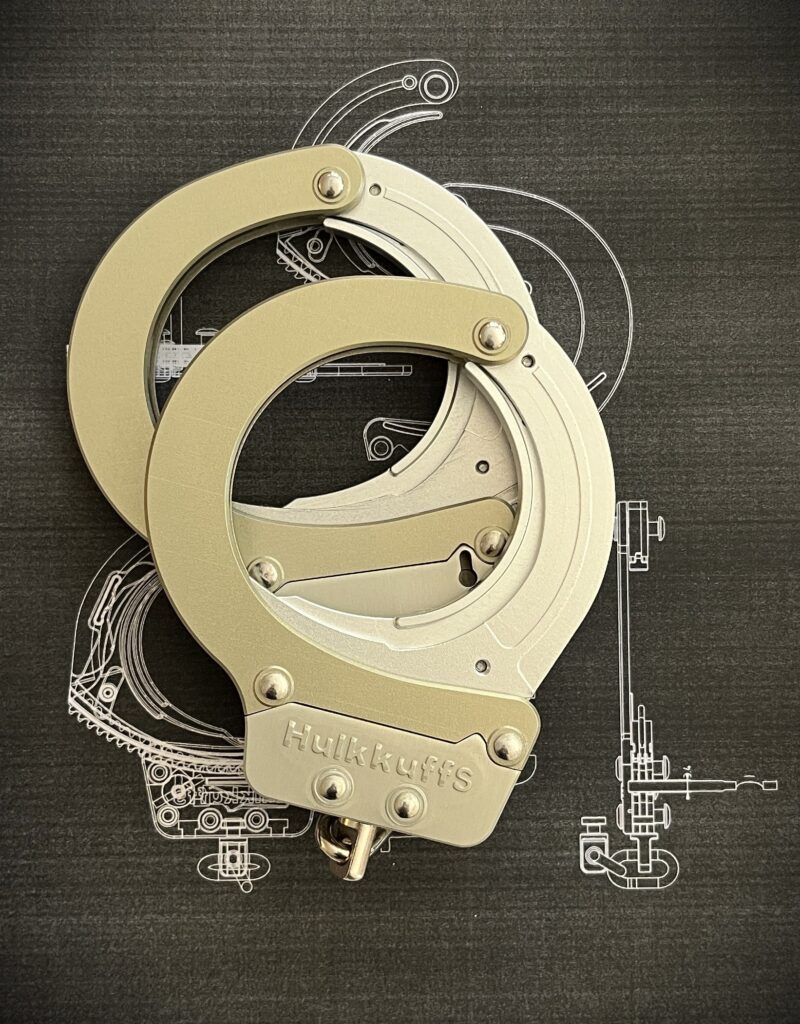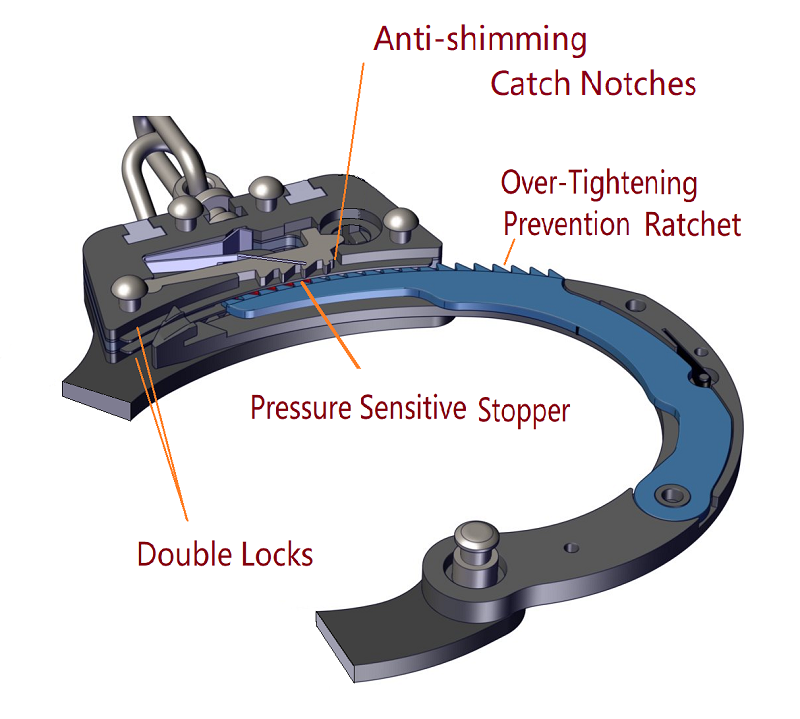Over-tightening prevention handcuffs
Triple lock, fully automatic, with over-tightening prevention. Modernized handcuffs. Made in Canada.
Law enforcement officers are exploring options for a modernized handcuff design. The current handcuffs utilise an intricate double lock. The lock is engaged manually by flipping a lever inside the key hole. It is often difficult or not possible to engage when officer apprehension involves a struggle, and can result, on occasion, in injury to the individual police officer, the individual, or both. –—–Canadian RCMP challenge 2021.
Safer, faster and automatic, no more over-tightening in handcuffing
Triple lock design: Two independent locks to prevent from being picked, One tension-sensitive lock to prevent from getting over-tightened.
1, Reliable pressure-activated lock, never get over-tightened.
2, 360 degrees protection, from small to large wrist, without dead angles.
3, Widened contacting surfaces, reduce impact pressure by 75%.
4, Fully automatic, true triple locks, 80% more secure than double lock handcuffs.
The only fully automatic handcuffs
The latest Hulkkuffs® solutions integrate multiple functions into handcuffs.
1), Over-tightening prevention with a independent pressure-activated lock,
2), Automatic lock and secure system, no push-to-lock lever, 75% faster in cuffing,
3), Integrated unlocking mechanism, 75% faster in removal,
4), Anti-shimming and picking, by double U-shaped catching notches,
5), two Independent ratchet locks , 8 times longer in picking resistance,
6), Reduce impact pressure in speedy cuffing, or spring shut, with soft cushion springs,
7), False-locking eliminated: never activated before securely applied on wrist.
What is new in 2026 Canadian Edition
2026 edition
1, Improved pressure-sensitive lock, smoother and more accurate.
2, Patented reverse-action mechanism, protects all sides of wrist, dead angles eliminated.
3, More models / materials / colors options are available in 2026:
Available models:
Chained, Hinged, Rigid,
Tempered aluminum alloy (6061), light weighted, strong and low cost.
Strength to weight ratio is greater than steel.
Aviation aluminum alloy (7075), light weighted, very strong.
Strength to weight ratio is much greater (almost doubled) than steel.
Colored:
Nature aluminum colors, light grey, dark blue and dark blue.
Modernized Handcuffs with injury prevention and automatic locks
A), Handcuffs have been used for over hundreds of years. It is not unusual to be applied in violent circumstances or for the individuals who struggles, over-tightening injury may occur on occasion. In speed cuffing tactics, handcuffs are applied by allowing the ratchet to spring shut (swing-thru cuff), this may lead to direct trauma. Superficial radial neuropathy is the most common injury.
B), Although police officers are properly trained in the use of handcuffs, including how to apply and remove them from individuals. Certain situations or individuals sometimes present great challenges to engaging the intricate double locking system, which can result, on occasion, in injury to the individual police officer, the individual, or both.
C), Major injuries in handcuffing, or handcuffed.
1), Over-tightening injury for handcuffed individual,
2), Direct trauma injury in spring shut, or speed cuffing,
3), Other injuries in handcuffing: the small lock tip or actuator has to be flipped to lock the handcuffs manually, this is difficult, dangerous or even not possible when apprehension involves struggles.
The modernized handcuffs developed by Hulkkuffs® Canada reduce and prevent most injuries in most situations.
More than just over-tightening prevention
Faster, Safer and more Reliable in operating.
Simplified processes in cuffing and removing, results less injuries for both police officer and individual.
The new designs utilize two independent locks and one fully automatic pressure-triggered lock.
1), The mechanisms are to engage and lock automatically, even when an individual is struggling or being non-compliant with officer directions, without pushing the lock lever manually,
2), The pressure-triggered lock secures the moving ratchet immediately when excessive force is applied, and any further tightening is prevented.
3), Once the handcuffs are placed on an individual with a pressure greater than pre-set, the mechanism locks the handcuffs in both directions; any further push-tightening, self-tightening or/and removing are completely disabled.
4), The automatic lock and un-lock mechanisms reduce cuffing and removing time significantly, and are critical when apprehension involves a struggle.
5), The over-tightening mechanism is not activated before the handcuff is securely applied on a wrist. False locking never happens.
The research and development of the new handcuffs have been sponsored by RCMP (The Royal Canadian Mounted Police) and ISED (Innovation, Science and Economic Development of Canada).
Read more about over-tightening prevention designs.
The R&D of this handcuffs was partially funded by the government of Canada.






